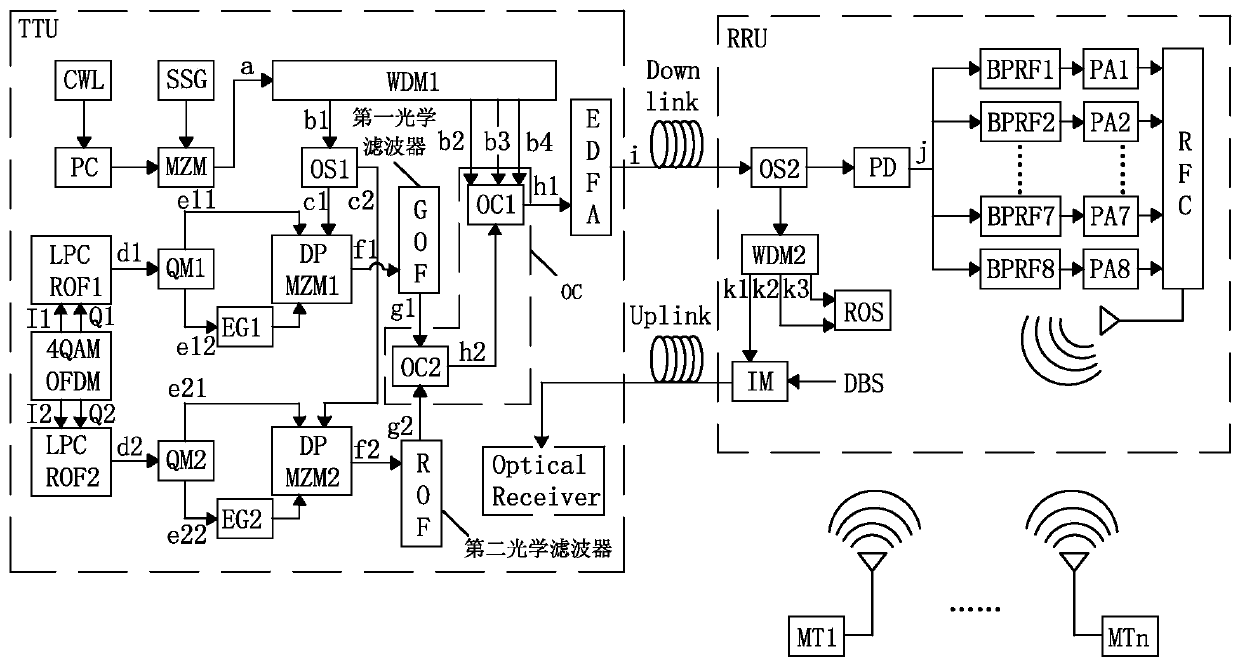Transmitting terminal, a fiber-optic wireless multi-carrier communication system and a signal processing method thereof
A light wave signal and sending terminal technology, which is applied in the field of information and communication, can solve the problems of nonlinear optical effect, low spectral utilization rate, unfavorable information demodulation, etc., to achieve spectral utilization rate, communication rate and reduce bit error rate Effect
- Summary
- Abstract
- Description
- Claims
- Application Information
AI Technical Summary
Problems solved by technology
Method used
Image
Examples
Embodiment 1
[0061] Such as figure 1 As shown, a fiber optic wireless multi-carrier communication system includes a transmitting terminal TTU, a radio remote unit RRU, a mobile terminal unit MT, a downlink fiber Downlink and an uplink fiber Uplink. The sending terminal TTU includes a downlink and an uplink; the downlink communicates with the remote radio unit RRU through the downlink optical fiber Downlink; the uplink communicates with the remote radio unit RRU through the uplink optical fiber Uplink. The remote radio unit RRU communicates with the mobile terminal unit MT through a wireless link.
[0062] Such as figure 1 As shown, in this embodiment, the transmitting terminal TTU includes: a continuous wave laser CWL, the output end of which is connected to the input end of the polarization controller PC; the polarization controller PC, whose output end is connected to the input end of the Mach-Zehnder modulator MZM; The signal generator SSG, the output end is connected to the modulatio...
Embodiment 2
[0166] The difference between this embodiment and Embodiment 1 is that the center frequencies of the four optical signals b1, b2, b3, and b4 output by the first wavelength division multiplexer WDM1 are not 193.18THz, 193.15THz, 193.12THz, and 193.09THz, but 193.00THz、193.01THz、193.02THz、193.03THz、193.04THz、193.05THz、193.06THz、193.07THz、193.08THz、193.09THz、193.10THz、193.11THz、193.12THz、193.13THz、193.14THz、193.15THz、193.16THz , 193.17THz, 193.18THz, 193.19THz, 193.20THz in the four optical signals, such as 193.04THz, 193.08THz, 193.12THz, 193.16THz, the center frequency of the eight-channel RF carrier output after the photon detector PD heterodyne beat frequency 5GHz, 10GHz, 45GHz, 50GHz, 85GHz, 90GHz, 125GHz, 130GHz respectively; if the center frequencies of the four optical signals b1, b2, b3, b4 output by the first wavelength division multiplexer WDM1 are 193.04THz, 193.06THz respectively , 193.08THz, 193.10THz, then the center frequencies of the eight RF carriers output by t...
Embodiment 3
[0168] The difference between this embodiment and Embodiment 1 is that the modulation frequencies of the first quadrature modulator QM1 and the second quadrature modulator QM2 are not 5GHz and 10GHz; for example, the modulation frequency of the first quadrature modulator QM1 is 5GHZ, and the modulation frequency of the second quadrature The modulation frequency of the two quadrature modulators QM2 is 15GHz, then the center frequencies of the eight RF carriers output by the photon detector PD after heterodyne beat frequency are 5GHz, 15GHz, 45GHz, 50GHz, 85GHz, 90GHz, 125GHz, 130GHz respectively.
PUM
| Property | Measurement | Unit |
|---|---|---|
| Extinction ratio | aaaaa | aaaaa |
Abstract
Description
Claims
Application Information
 Login to View More
Login to View More - Generate Ideas
- Intellectual Property
- Life Sciences
- Materials
- Tech Scout
- Unparalleled Data Quality
- Higher Quality Content
- 60% Fewer Hallucinations
Browse by: Latest US Patents, China's latest patents, Technical Efficacy Thesaurus, Application Domain, Technology Topic, Popular Technical Reports.
© 2025 PatSnap. All rights reserved.Legal|Privacy policy|Modern Slavery Act Transparency Statement|Sitemap|About US| Contact US: help@patsnap.com



